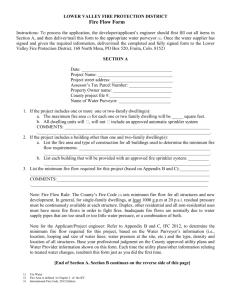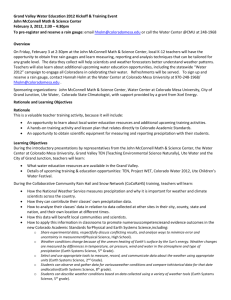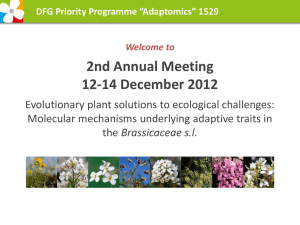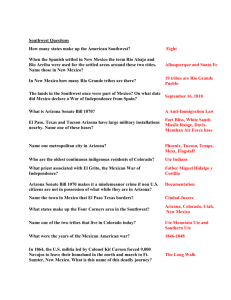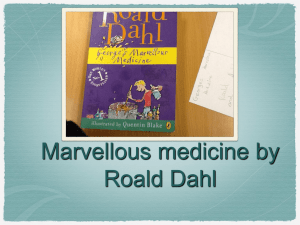ISTD ute language final paper 2
advertisement
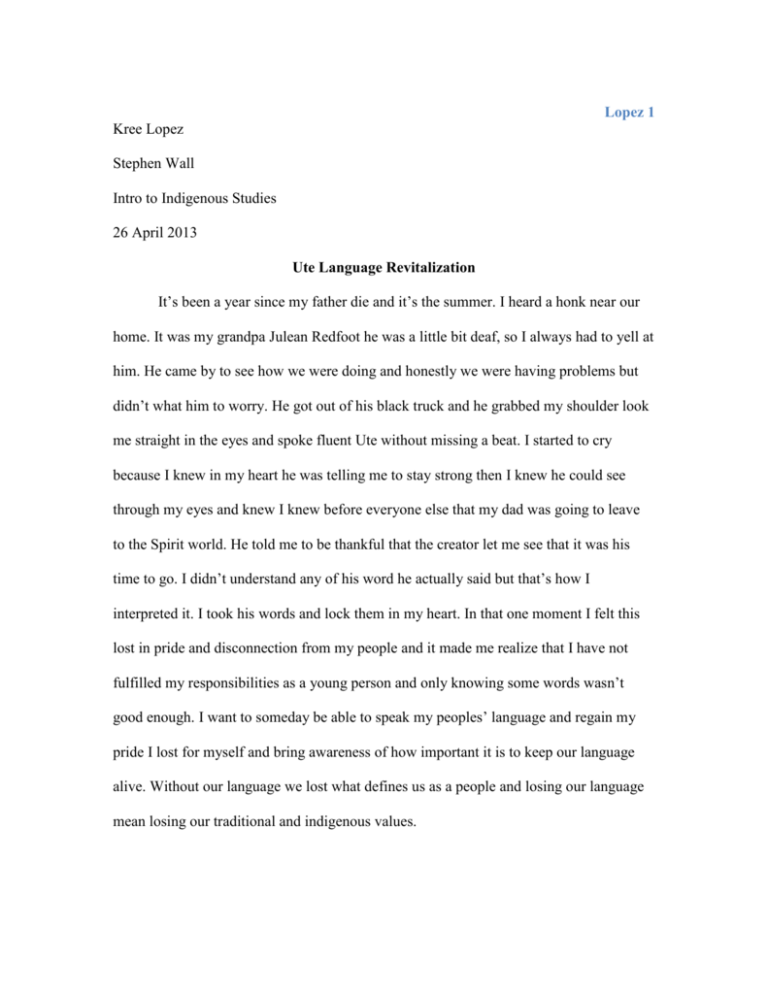
Lopez 1 Kree Lopez Stephen Wall Intro to Indigenous Studies 26 April 2013 Ute Language Revitalization It’s been a year since my father die and it’s the summer. I heard a honk near our home. It was my grandpa Julean Redfoot he was a little bit deaf, so I always had to yell at him. He came by to see how we were doing and honestly we were having problems but didn’t what him to worry. He got out of his black truck and he grabbed my shoulder look me straight in the eyes and spoke fluent Ute without missing a beat. I started to cry because I knew in my heart he was telling me to stay strong then I knew he could see through my eyes and knew I knew before everyone else that my dad was going to leave to the Spirit world. He told me to be thankful that the creator let me see that it was his time to go. I didn’t understand any of his word he actually said but that’s how I interpreted it. I took his words and lock them in my heart. In that one moment I felt this lost in pride and disconnection from my people and it made me realize that I have not fulfilled my responsibilities as a young person and only knowing some words wasn’t good enough. I want to someday be able to speak my peoples’ language and regain my pride I lost for myself and bring awareness of how important it is to keep our language alive. Without our language we lost what defines us as a people and losing our language mean losing our traditional and indigenous values. Lopez 2 My ancestors called themselves Nuchu which means “the people” but there are different various of the word depending on the Ute band and what this is saying is the Ute belong in the “land of the shining mountains” where the creator had put us. To be honest the Ute name came from a Spanish explorer named Friar Salmeron who was visiting New Mexico in the 1604. In his journal he noted that the pueblo he met had spoke of a group of Indians to north called Guaguatu or Guaputa and how they spoke a Shoshoni dialect and it was different from the pueblo. Friar had called them as “Quasuatas” another form of the words “Yutas” Salmeron and other Spanish writer called all the people that spoke Shoshoni dialects but later on people just started called them Utes. (Ute Memories 1) In the Ute creation legend implies that the Utes migrated from the south and there is evidence to support this idea because the Utes speak a Shoshoni dialect that belongs to the Uto-Aztecan language that spans out from the Rocky mountain to the Popocatepetl Volcano south of Mexico city, Within Northern Uto-Aztecan, Ute belongs to the Numic sub-family, The northern- most branch. Within the Numic, Utes are a part of the closely related with the Southern Numic languages. It’s believes the branch seperated from other speakers moved to Southern California. Over time the various family group began developing significant language various, even though the live close. Due to that resulted spilting the Numic Language branch into three sub-families: Northern (The Shoshone Cluster), the Central Numic (The Northern Paiutes Cluster), and the Southern Numic (Chemehueve, Kawaisu, Southern Paiutes, and Utes). Anthropologists suggest the Numic people spread South-eastern California in two waves. The Northern and Central began spreading as far as back as 2,500 years ago. (The migration of the Southern branch from California within the last 1,000 years.) The two groups, Chemehueve and Kawaisu, are Lopez 3 still in California and the Southern Paiute went to the Colorado River and Grand Canyon and the Southern Paiute processed up north up toward Kiabad plateau of Utah. The Utes migrated farther up the rivers and into Colorado Rockies and the mountain of the eastern Utah. Thus, making the Northern Paiute and Shoshone clusters are distinct languages, Utes, Southern Paiute, Chemehueve and Kawaisu can be consider closely related dialects of the same language, that separated by the 500-to-1000 years. (Givon, Talmy 27) There are differences between the speeches, in the article I found, compares two languages that are a part the Numic branch like the examples he gives of the Southern Paiutes and Southern Ute, have a different dialect and rates in the speech, and they were comparable to the American and an Englishman to try and communicate. If you look at a different branches that like the Northern Utes and the Shoshone, and there is problem of understanding would increase dramatically. They say the group were comparable to American and would attempt to understand Dutch person, which both languages belong to the same Germanic branch of the Indo-European language family. So each Numicspeaking group faced a challenge to venture from their homes. (Ute Memories 5) Around 1000 A.D all three groups moved and expanded. 1050 A.D the Utes moved into the intermountain region. So the groups lived in their new home and began to spill up into eleven bands and were named for the areas they lived before the Europeans came. The Utes were split into eleven to twelve bands. Mouache, lived on the eastern slopes of the Rockies Mountains, The Capote inhabited San Luis Valley, Tabeguache also known as Tivinwach and Uncompahagre, lived in the central Colorado, White River Utes also known as Parianuche and Yamparika lives in the valley of the white, Weenuche live in the valley of the San Juan River, Shebretch a tiny band lived near Moab, Utah, Uintah Lopez 4 lived in the large Uintah Basin, Tumpanwach and southern and eastern of Utah lake, San Pitch lived Sanpete Valley, Moanumts inhabited the upper Sevier River, Phavant band areas desert surrounding the Sevier lake. (Utes Memories 5) These bands were then put together to form todays Utes. The Mouach and Capote make up the Southern Utes and Weeminuche is the Ute Mountain Utes and the Unitah, Ouray, Uncompahagre, are the Northern Utes. Due the absent of importance of how important it is to bring language back has effected our spiritual dances like the bear dance. They say a she bear have gave us the dance to celebrate the spring and a coming of a new year and to honor the bear spirit. My grandfather say that the bear gave us four songs to sing and in those song they are Ute words in the song and they have different meaning of what stage of the dance your and now when you go to the bear dance its like we are losing that power that we are suppose to celebrate the new year and bear. Those old singers are gone and once something gone our identity as Ute people will be gone. I remember when I was a little girl that my family in Towaco, Colorado would speak Ute all the time and when I visit my family in Fort Duchesne, Utah it was the same, until I moved to Ignacio, Colorado I felt the people was a little different not many kids knew what they roles they play. I went to school at the Southern Ute academy and learned how to speak Ute in the school. We learned the colors and how to count to 10 and to choose a name we wanted to be called. I wanted to be called purple butterfly, so the teacher was calling me that but I asked my aunt Nadine who was Northern Ute how to say purple butterfly and she told me and it sounded was different from what I was hearing and I told her what my teacher was say and she looked at me and laughed. I looked at her and ask what’s so funny and she said she was calling me purple donkey and I was so Lopez 5 embarrassed and upset but my grandma Renee Cloud told me it was right the way the teacher told me. I though to myself I Thought we were the same, because we have the same name at the end. As of today I found out there are differences between the Northern Ute dialect that is called Chemehuevi and the Southern Utes use the Kaiba dialect. In my generation I notice that the kids I went to school don’t even bother with their culture and traditions values they are more into todays modern values and aren’t interested in their culture. I spoke to my grandpa Neil Cloud and he had told me during our interview that there was no point our language has been gone for a long time. I refuse to let that get me and I ask which Ute group knows the ancestral tongue and he replied the Northern Ute. My grandma also agrees that we lost our language due to the lack of reinforce at home and the Ute mountain Utes and Northern Ute are in better stand than the Southern Ute. She also notices that all three tribes have a different dialect and have a different meaning from a word that sounds similar. My grandma says that the language should be taught at home in the oral tradition because they never had to read or write our language its just confusing our children. Both my grandparents notice the mistakes of the linguist, for example a women who had study our language had claim that our language had German in it and that’s not true at all and my grandpa was saying she was confusing people. When my grandma sit at the Ute language notice the mistakes they make with the writing and the way it suppose to be said and felt like she wasn’t welcome because she speaks Ute fluently and feels that she was getting in the way. I asked both which method should the cultural department should be using and their response was the Givon method. My grandfather had given me examples when a Lopez 6 word has a line under a few of the letters then its silence but to be prepared to have a syllable after it creating another word. The reason it’s the most accurate was he and few other were working with Dr. Givon on the project. Our language has some influence from the Spanish since we had a good standing with them in the past. So the word Kava that means horse is a fine example of their influence. Both my grandparents were taught at home and Ute was their first language and English their second. Their parents Molly T Buck and Julius N Cloud had used a method that seem to work every time making their children speak Ute all the day and everyday. They never had to write it down or read it they learn their language orally. So my grandma believe it should be taught at home and orally. The big issue is we lost a lot of generations in 1930’s and 60’s when the Ute’s children were taken from their homes and forced not to speak their language and may have caused trauma and created fear to speaking their native tongue, and because there are not that many people that know their language and the effect is causing the Ute to lose more generations. The Cultural Department are trying to make solutions to help the youth to gain interest in their culture again, but are trying to catch up with the other Ute bands. Right now they are teaching Ute with the Givon method and are teaching the interested group that wants to learn Ute. The Department got together in Denver with the other Ute tribes and began talking about how they plan on making a Ipad app and using only using 500 word and putting all four of the Utes tribe in that one program to get all four ways of saying that one word. It’s not going to have it written because it would make the app more expensive and to focus how it supposes to be taught oral tradition. Lopez 7 So if you more interested in learning how to say it as a Northern Ute then you could focus on how they say it. This programs won’t be summited till four to six months and won’t be done till next year. They also want to make classes away from the public school and make classes in the public school systems. I had something open my eyes to realize that we need our language. It is our responsibility to learn our language as it our job to pass down our knowledge of ancestor to our youth. I still want to learn as much as I can about my people before that knowledge is gone as our identity as Ute people needs to be important. “Our Ute language is the strength and identity of our Ute people, without our language we are just a people.”- Ute elder “Nooh ah pah guh”-Northern Ute “Nuu cap ag’ga”-Southern Ute “Speak Ute “ Works cited Cloud, Neil. Personal interview. 31 Mar. 2013. Cloud, Renee. Personal interview. 31 Mar. 2013. Givón, Talmy. Ute Reference Grammar. [N.p.]: John Benjamins Publishing Co, 2011.eBook Academic Collection (EBSCOhost). Web. 28 Apr. 2013. Jenks, Clairinda. Personal interview. 13 Apr. 2013. "What Is a Ute?" Ute Memories. Utefans.net, Mar. 2006. Web. 9 Mar. 2013.


